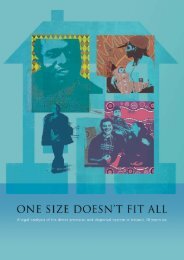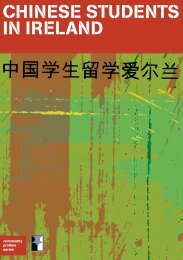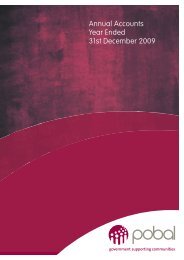Intercultural Education in the Post-Primary School - National Council ...
Intercultural Education in the Post-Primary School - National Council ...
Intercultural Education in the Post-Primary School - National Council ...
You also want an ePaper? Increase the reach of your titles
YUMPU automatically turns print PDFs into web optimized ePapers that Google loves.
ASSESSMENT AND CULTURAL DIVERSITY 7Assessment of learn<strong>in</strong>gAssessment for learn<strong>in</strong>g• happens after <strong>the</strong> learn<strong>in</strong>g takes place• <strong>in</strong>formation is ga<strong>the</strong>red by <strong>the</strong> teacher• <strong>in</strong>formation is usually transformed<strong>in</strong>to marks or grades• compares performance with <strong>the</strong>performance of o<strong>the</strong>rs• looks back on past learn<strong>in</strong>g• focuses on <strong>the</strong> <strong>in</strong>dividual• often plays a significant role onselection.• is an <strong>in</strong>tegral part of <strong>the</strong> learn<strong>in</strong>g process• <strong>in</strong>formation is shared with <strong>the</strong> learner• <strong>in</strong>formation is available on <strong>the</strong> qualityof learn<strong>in</strong>g• compares performance with aims andobjectives is important• looks forward to <strong>the</strong> next stage oflearn<strong>in</strong>g• focuses on <strong>the</strong> <strong>in</strong>dividual and on groups• outcomes are focused onprogress<strong>in</strong>g learn<strong>in</strong>g.Performance-based assessmentThe use of performance-based assessment<strong>in</strong>volves <strong>the</strong> follow<strong>in</strong>g:• Show<strong>in</strong>g <strong>the</strong> learners a variety ofexamples of good performance - samplework reports, student journals, projects,essays, practical work, videotapes oforal presentations, etc.• Encourag<strong>in</strong>g students to discuss why<strong>the</strong>se samples show good performanceand so agree <strong>the</strong> criteria for goodperformance.• Provid<strong>in</strong>g opportunities for students tomodel good performance <strong>the</strong>mselveswith teacher guidance and support.• Provid<strong>in</strong>g positive feedback on <strong>the</strong>process of learn<strong>in</strong>g as well as <strong>the</strong>product.• Allow<strong>in</strong>g students to assess <strong>the</strong>ir ownwork and submit <strong>the</strong> best examples aspart of summative assessment.Self-assessmentOne of <strong>the</strong> most important components ofassessment for learn<strong>in</strong>g is <strong>the</strong> use ofstudent self-assessment. Self-assessment,with clearly def<strong>in</strong>ed aims and criteria canenable students to identify <strong>the</strong>ir ownstrengths and weaknesses as learners, toevaluate progress <strong>the</strong>y have made, and tosuggest steps for improvement. Moststudents enjoy well-planned and carefullystructured self-assessment activities. Theycan be a motivation for students and canencourage self-directed learn<strong>in</strong>g.Suggestions for improvement are <strong>in</strong>tegralto <strong>the</strong> self-assessment process, but it isimportant that students make <strong>the</strong>ir ownsuggestions as to how <strong>the</strong>y might improve.This <strong>in</strong>volvement of <strong>the</strong> student <strong>in</strong> <strong>the</strong>assessment strategy will by its nature be alearn<strong>in</strong>g process for teachers and studentsalike. It will <strong>in</strong>volve a new way of look<strong>in</strong>gat assessment to facilitate learn<strong>in</strong>g and toengage parents/guardians and <strong>the</strong> student<strong>in</strong> achiev<strong>in</strong>g <strong>the</strong>ir own goals and targets.<strong>Intercultural</strong> <strong>Education</strong> <strong>in</strong> <strong>the</strong> <strong>Post</strong>-<strong>Primary</strong> <strong>School</strong> 97
















